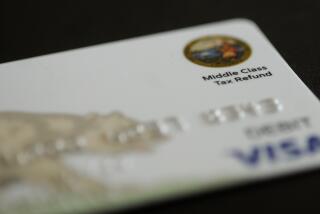Callers Can Reach Out and Touch Some Cash
- Share via
It may be time for big talkers to start pulling out their phone records.
An obscure federal tax on long-distance telephone service, imposed in the late 1800s to fund the Spanish-American War, is finally being phased out because of court challenges. The result: Millions of customers are due refunds for taxes that they’ve paid in the last three years.
“Everybody is going to have an interest in this,” said Eric Smith, a spokesman for the Internal Revenue Service. “Anyone who has paid for long distance services would be due a refund.”
For people who don’t spend a lot of time gabbing on the phone, the refunds could be minimal -- anywhere from $20 to $50 a person. But for those who regularly pay substantial bills for long-distance and cellular service, the amounts may be well worth documenting.
“We had a charge of $3.79 last month. You add that up and it’s $147” over a little more than three years, Bill Hardekopf, chief executive of SaveOnPhone.com, a Birmingham, Ala.-based phone discount comparison service, said, referring to his small company’s phone bill. “That’s worth pulling records for.”
Virtually anyone who has paid for long-distance or cellular phone service in the last three years is entitled to a refund. But nothing is automatic. You’ll need to file a refund claim when you file your 2006 federal income tax return, Smith said. Even people who don’t need to file 1040 forms because they don’t earn enough to pay taxes may want to file next year simply to claim this refund, he added.
The federal excise tax was levied on telephone services in 1898 as a temporary measure to help pay for the Spanish-American War. Like many taxes in those days, it was meant to hit only the wealthiest Americans. The telephone was a rarity then, having been invented only 22 years earlier. The war was short, lasting a mere eight months, but the tax was never repealed.
Indeed, it became deeply ingrained in the tax law, revised slightly as phone service became more common and sophisticated. In 1965, the tax law was updated, defining three separate types of phone service subject to the tax -- local, toll and “teletypewriter exchange services.”
But as time went on, the definition of “toll” service became a problem, said Mitchell Brecher, partner at the Washington office of law firm Greenberg Traurig. That’s because when the law was updated, toll charges were defined as those based on the amount of time elapsed and the distance of the call. In those days, calls from Los Angeles to San Francisco, for example, cost less than calls from L.A. to New York.
That’s no longer true. Most long-distance companies charge a flat per-minute rate, no matter the distance of the call, Hardekopf noted. Some cellular providers go a step further, making no distinction between local and long-distance calls.
As companies realized that the law authorizing the tax had not kept up with changes in phone service, they began to file legal challenges, Brecher said. The IRS defended the tax in court, saying the definition was unimportant, but courts consistently ruled against the government. If the charges for a call were not based on the call’s distance, the tax could not be applied, several courts ruled.
Late last month, the government announced it would no longer fight the legal challenges. It has notified phone companies, which collected the tax through monthly phone bills, to stop levying the charge. And the agency said it would refund excise tax payments made after Feb. 28, 2003, to all taxpayers who file a claim. An excise tax will still be levied on local phone service, however.
The IRS is trying to figure out how to handle more than 100 million expected refund claims, many of which are likely to be for small amounts. The agency said all refund requests should be made on 2006 returns, which can’t be filed until January.
The agency is working to add a line to the commonly used tax forms -- the 1040, 1040A and 1040EZ -- to provide a simple way to make a claim. It also is considering creating new forms for people who don’t normally file returns, because they don’t earn enough to owe tax, so they can file an excise tax refund claim with minimal hassle.
The agency expects to have two methods for figuring refund amounts. One would be a simplified method that would not require taxpayers to provide any documentation of how much tax they have paid. Those who have spent modest amounts on long distance and cellular service are likely to see that option as the better one.
But it’s not likely to produce much of a refund. The IRS has not determined the safe harbor amount, but it is likely to be less than $50 because the average consumer spent less than $1 a month on the tax.
The other method will require compiling phone records. For those who spend hundreds of dollars a month on long-distance and cellular bills, this is likely to be the better choice, the IRS’ Smith said.
The tax amounted to 3% of “toll” or “bundled” charges. Consequently, a consumer who paid $250 a month in such charges since Feb. 28, 2003, would be filing a claim for about $300 in overpaid taxes.
“The people who spend a lot on calls might want to get their records together,” the IRS spokesman said. “This is a 3% tax. For a lot of people, that’s not very much money. But, for some people, it could be a lot.”


